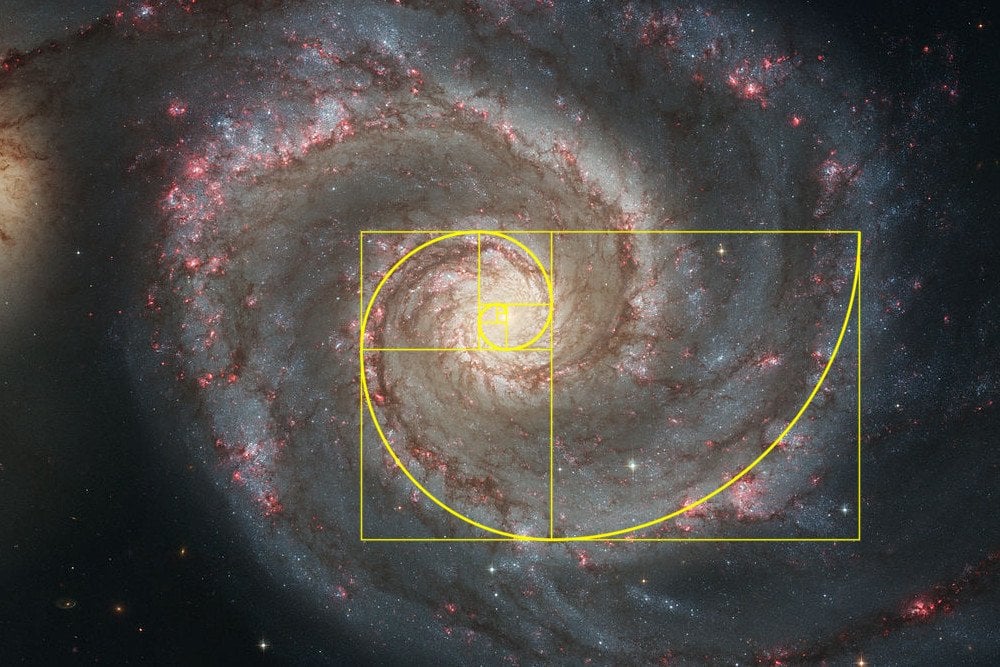The Golden Ratio (φ) and The Fibonacci Sequence
The Golden Ratio (φ) and The Fibonacci Sequence
The meaning of these pictures will become clear later...

The meaning of these pictures will become clear later...

Assume that
- Rabbits start to reproduce two months after their own birth
- Each pair (old enough to reproduce) produces a mixed pair monthly (one male, one female)
- No rabbits die
The number of pairs will follow the following sequence
1, 1, 2, 3, 5, 8, 13, 21, 34, 55, 89, 144
After 12 months (one year) there will be 144 rabbits.
This sequence is generated by adding the two previous numbers together to get the next one
1 + 1 = 2
1 + 2 = 3
2 + 3 = 5
3 + 5 = 8
5 + 8 = 13
and so on...
The sequence is called the Fibonacci sequence and the numbers are called the Fibonacci numbers.
The formula for a Fibonacci number is given by:
The nth number = the sum of the previous two numbers
As the sequence continues to grow, the numbers settle into a pattern which you may not immediately see.
If we look at the ratios when each number is divided by its previous, smaller number you can spot the pattern.
1 / 1 = 1
2 / 1 = 2
3 / 2 = 1.5
5 / 3 = 1.6666...
8 / 5 = 1.6
13 / 8 = 1.625
21 / 13 = 1.6153...
34 / 21 = 1.6190...
You can see the numbers seem to get closer to a value around 1.618. This means if you take a Fibonacci number; to get to the next one you can multiply by this value.
As the Fibonacci numbers get bigger the ratio between the numbers becomes clear so lets take two bigger Fibonacci numbers
19392 / 11984 = 1.61815754...
So we know
if we times a previous Fibonacci number by 1.61815.... we will roughly get the next Fibonacci number.
the bigger the Fibonacci numbers we used to obtain the ratio; the closer we will be to the exact ratio.
We can see this clearly since
1 / 1 gave us a ratio of 1
but 8 / 5 gave us a ratio of 1.6
So whats special about this 1.61815... number? Firstly lets see if we can get an accurate idea of what the number is exactly.
Finding The Golden Ratio
We know
If we say Fn = a + b
Fn - 1 = a
Fn - 2 = b
We will now call the ratio the golden ratio and represent it using φ (phi)
So this calculation tells us the ratio of the Fibonacci numbers tends to
1.6180339887498948482... known as φ (phi)
as the Fibonacci numbers get larger and larger.
This continues forever meaning φ is another special irrational number like pi and e. These numbers all continue forever.
So what's so special about this golden ratio and Fibonacci numbers?
Well no one exactly knows. What we do know however is that they always seem to pop up in the universe.
Things that use Fibonacci numbers and The Golden Ratio
- The shape of playing cards
- Greek art
- The shape of human faces
- Animal body shapes
- Architecture
- φ can allow something called a logarithmic spiral which spiral galaxies seem to follow

- The number of petals on a flowers
- The way petals are arranged
- Pine cone seedpods are arranged in a spiral pattern and the number of steps in them will usually match a pair of consecutive Fibonacci numbers

- The number of branches on a tree
- Animal shells seem to follow logarithmic spirals
- Hurricanes follow these spirals as well
- The ratio of a DNA's molecules length to width is roughly φ
There are loads more places this comes up and there is so much more Maths behind the sequence and similar sequences such as the Lucas Number's. I encourage to read about them if any of this interested you.
Thanks for reading and I encourage you to leave comments about your thoughts on the topic, things I haven't covered in this post, how you think I can improve my posts, what you liked about this topic etc..
If you enjoyed this post or any of my others, follow this blog.
Be sure to also share this around with your friends and family.




Comments
Post a Comment